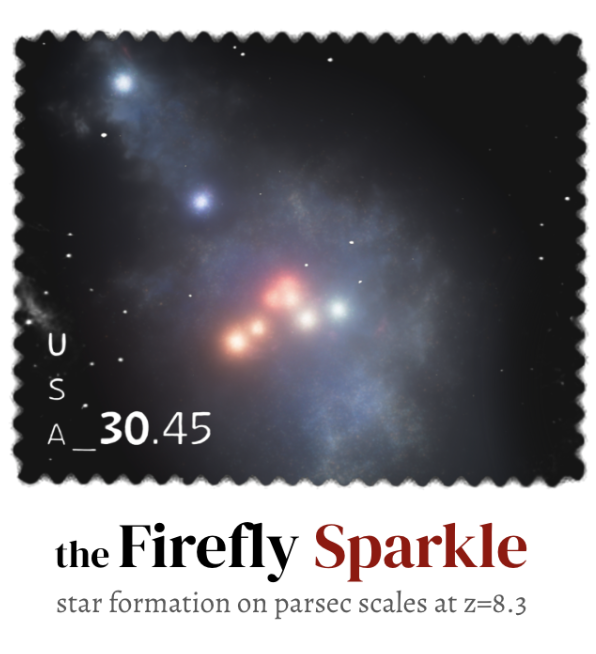Sparkly Stuff

In 2022, a day after we got access to JWST's first deep field (SMACS 0723), we found a galaxy that we nicknamed "The Sparkler"1 because it was surrounded by many bright compact objects (i.e., sparkles). By using the multiwavelength light from the sparkles, we showed these objects were likely globular clusters - the same type of ancient star clusters we see orbiting our Milky Way today, but seen at a time shortly after they had just formed, over 9 billion years ago. Thanks to JWST’s incredible angular resolution and magnification of the galaxy by gravitational lensing, this was the first time we'd been able to resolve and study such distant globular clusters, opening a new window into understanding how these ancient stellar systems formed. You can read more about the Sparkler galaxy and explore the data on the CANUCS website or read the paper led by Lamiya Mowla & me1 below.
More recently, the CANUCS team discovered the Firefly Sparkle galaxy2 in JWST observations of the MACS 1423 cluster. This galaxy exists even further back in time, when the universe was only 600 million years old. What makes it particularly interesting is that it has about the same mass we think the Milky Way had at that age. Most galaxies we find from this early epoch tend to be much more massive, so the Firefly Sparkle gives us a rare opportunity to study how more typical galaxies like our own first assembled. You can read more about the galaxy in this NASA press release.
These discoveries are part of my broader research using JWST to understand the formation of globular clusters and their ties to galaxy assembly, but also trying to understand star formation in extreme environments at high redshifts. By studying these ancient systems, we're piecing together how galaxies like our Milky Way built up their stars and structure over cosmic time. The work on the Sparkler was published in ApJL1 and the Firefly Sparkle discovery appeared in Nature2.
-
Lamiya Mowla, Kartheik G. Iyer, Guillaume Desprez, Vicente Estrada-Carpenter, Nicholas S. Martis, Gaël Noirot, Ghassan T. Sarrouh, Victoria Strait, Yoshihisa Asada, Roberto G. Abraham, Gabriel Brammer, Marcin Sawicki, Chris J. Willott, Marusa Bradac, René Doyon, Adam Muzzin, Camilla Pacifici, Swara Ravindranath, and Johannes Zabl. The Sparkler: Evolved High-redshift Globular Cluster Candidates Captured by JWST. \apjl , 937(2):L35, October 2022. arXiv:2208.02233, doi:10.3847/2041-8213/ac90ca. ↩↩↩
-
Lamiya Mowla, Kartheik Iyer, Yoshihisa Asada, Guillaume Desprez, Vivian Yun Yan Tan, Nicholas Martis, Ghassan Sarrouh, Victoria Strait, Roberto Abraham, Maruša Bradač, Gabriel Brammer, Adam Muzzin, Camilla Pacifici, Swara Ravindranath, Marcin Sawicki, Chris Willott, Vince Estrada-Carpenter, Nusrath Jahan, Gaël Noirot, Jasleen Matharu, Gregor Rihtaršič, and Johannes Zabl. The Firefly Sparkle: The Earliest Stages of the Assembly of A Milky Way-type Galaxy in a 600 Myr Old Universe. arXiv e-prints, pages arXiv:2402.08696, February 2024. arXiv:2402.08696, doi:10.48550/arXiv.2402.08696. ↩↩